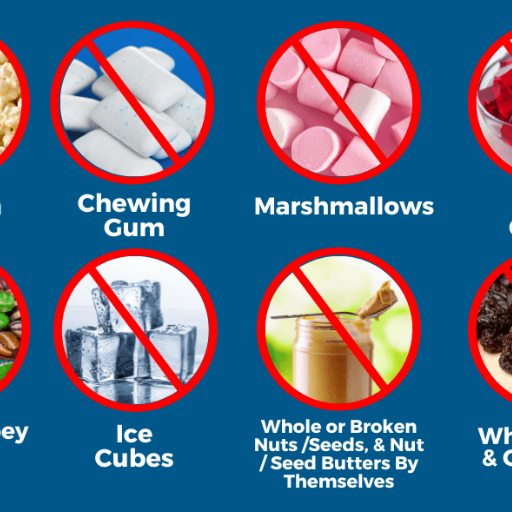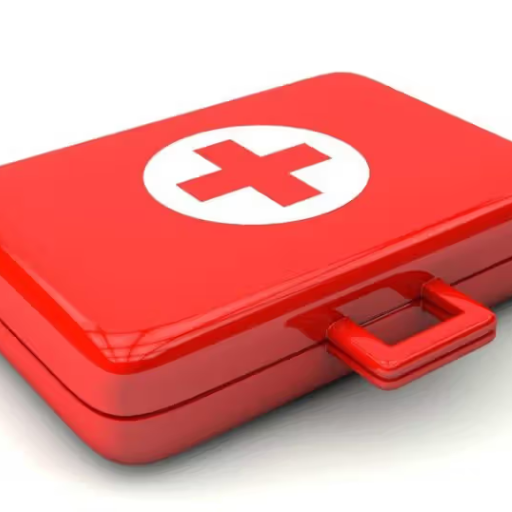
What are the Major Choking Hazards Adults Face?

Adults face several major choking hazards, primarily due to the consumption of improperly chewed food, which is the most common cause of choking. Foods such as meat, bread, and raw vegetables are particularly problematic if not adequately masticated. Additionally, certain medical conditions like dysphagia, common in individuals with neurological impairments or the elderly, exacerbate the risk of choking by impeding the normal swallowing process. Non-food items also pose significant hazards, particularly for individuals with dental prosthetics that may dislodge during eating, leading to accidental ingestion of foreign objects. Lastly, consumption of alcohol or sedatives can affect muscle control, increasing the risk of choking. Understanding these hazards is critical in reducing choking incidents through appropriate preventive measures and swift interventions when necessary.
Common Foods That Lead to Choking Death
The recurring theme regarding choking incidents in adults hinges on a particular set of foods that are notoriously difficult to swallow. A prime example is the steak, which is chewy and, if not well-chewed, can become a choking hazard. Hotdogs, on the other hand, are easy to eat. However, they are tubular in shape, which can pose a risk of choking. Other fruits and vegetables that contain thicker skin, such as grapes and apples, need to be eaten with care. Nuts and seeds, which are small in size, can be hazardous when eaten since they can easily get into the lungs on inhalation. I always encourage my patients to partake in active exercise and prepare hot meals which they enjoy. Focussed education about dialing eating practices is vital in decreasing the chances that such choking fares are ingested.How Small Objects Increase the Risk of Choking
I need to clarify the reasons why the presence of small objects poses a high choking risk, notably to vulnerable adults and populations. Most importantly, due to their dimensions, small objects may bypass some of the throat's protective mechanisms that are designed to stop larger objects from blocking the airway, making it essential to understand such threats while in possession of or in proximity to such small items. Small objects, such as pen caps, buttons, coins, and assorted toy parts, can lead to the blocking of the airways. When considering the reasons these objects represent a choking risk, some parameters are present that are worth noting:- Size and Shape: Any object that is small enough to fit inside the throat can act as a choke at some point when it gets lodged. Obstruct the airway with round and smooth objects which tend to be the most bothersome in anatomy because they can passively drop in the trachea.
- Material Composition: The same may be true of lite weight and hard things that have shown tendencies to be lodged inside tight places like plastic or metal coins since they become very hard to extricate. Such structure prevents them from adapting to the contours of the passage seeds physically which results in an obstruction.
- Human Reflexes: There is always the possibility that the throat's gag reflex mechanism could turn out to be a great aid against smaller foreign objects, but this, unfortunately, and more often than not, does not work equally well to expel ingested small objects if one has not paid attention to the matter and accidentally tries to ingest such an object.
- Activity Context: Also while talking, laughing or moving fast, even the smallest of the objects which may be in the mouth or close by can slip off and possibly get inhaled or swallowed which is highly not recommended.
Age Group Most Affected by Choking Incidents
I'm filled with knowledge of the industry and how people of all ages can choke. However, some age brackets have certain risk factors and situations that make them more susceptible to choking. Knowing these can help formulate effective prevention strategies.- Young Children: Notably, children below 5 have high reported rates of choking incidents, with the youngest ages being the youngest at risk. What’s more troubling is the fact that these children are hypoplastic and, therefore, exhibit a tendency to put things into their mouths to explore them. Furthermore, since their airways are not fully developed, it is very easy for foreign materials to enter.
- Older Adults: Due to several factors most seniors in the age bracket of sixty five years and above are also vulnerable. The elderly for example have most probably dysphagia which makes swallowing a problem. Not only that, but they may have jaw interdental splints that would cut down the effectiveness of mastication, which would elevate the chances of choking while consuming food.
- Individuals with Neurological Impairments: Most individuals, including those suffering from Parkinson's disease, cerebral palsy, or those who have had strokes, have challenges in muscle control, especially in muscles that aid in swallowing, which makes them all too prone to choking.
How Many Adults Die from Choking Annually?
 The annual number of choking deaths for adults is rather shocking. Even if no one wants to die, it is rather surprising that 4,000 to 5,000 adults, which is a large sample, are said to die of choking each year in the US alone. It is certainly rather sad, especially considering that they all could be prevented from dying by a slightly different approach to awareness raising, further preventive measures, or timely programs/interventions.
The annual number of choking deaths for adults is rather shocking. Even if no one wants to die, it is rather surprising that 4,000 to 5,000 adults, which is a large sample, are said to die of choking each year in the US alone. It is certainly rather sad, especially considering that they all could be prevented from dying by a slightly different approach to awareness raising, further preventive measures, or timely programs/interventions.
Statistics on Choking Deaths in the UK
I am in a position to provide the necessary data and information on choking deaths in the UK so as to clarify this worrying concept. In the UK, on average, choking causes an estimated 200 and 300 fatalities each year. Such a figure underscores the necessity of being careful to take measures to avoid such risks. To further inform your examination of choking incidents in the UK, here are some pertinent parameters:- Demographics: Children and elderly persons appear to be the most affected as is the case in the global picture. Since children explore their environment by using their mouths they can easily choke on small toys and pieces of food while older individuals may choke due to the effect of certain diseases on the swallowing mechanism.
- Situational Contexts: Most of the choking episodes happen during meal times and in settings where small items are found. For example, particular types of celebrations which involve a lot of food or uncontrolled areas of children can also activate the risk.
- Awareness and Education: The education of the public or society in general and the perception of the choking risk has a penetrative factor. This is because places where first aid training is up and running have better results since members of the society are able to assist in most cases.
- Emergency Response: The time it takes for paramedics to arrive at the scene and the presence of life saving techniques such as the Heimlich manoeuvre greatly influences the rate of survival.
Factors Contributing to Deaths Caused by Choking
It’s worth unpacking the components of this explanation regarding choking deaths as it will make them easier to comprehend and contextualize:- Object Size and Shape: The shape and size of the object ingested are crucial among the factors contributing to choking incidents. Anyone is prone to choking on smooth small and round objects as they easily make way down the trachea. This explains why children are always at risk of choking on safe for consumption items such as hot dogs, grapes, and hard candies.
- Material Composition: Specific types of plastic toys and coins are inflexible to the extent that they can wedged firmly into the throat after being swallowed. They are also light in weight thus they tend to stick instead of floating.
- Physical Reflexes: Inhibitory or protective reflexes rely on gag reflexes that may differ from one individual to another. In some cases, reflexes aren’t adequate or quick enough to eject a substance, for instance, in a situation where there’s too much movement of the head during swallowing.
- Activity Context:Heavy conversations or laughter or even moving one’s head and body around during a meal can also be a cause of choking. In social gatherings, eating without focusing can result in inhaling food or food being swallowed the wrong way.
Recent Trends in Choking Incidents
- Age Distribution Shifts: Recent statistics indicate a changing pattern in the demographics affected by choking incidents. While children and elderly adults remain the most vulnerable, data suggests a rising number of cases involving middle-aged adults, particularly in high-stress environments where distractions during meals are prevalent.
- Increase in At-Home Incidents: With more people working remotely, there has been an uptick in choking incidents occurring in home settings. This can be attributed to the increased frequency of unsupervised meals and the tendency to eat quickly while multitasking.
- Heightened Risk During Social Gatherings: Post-pandemic social gatherings have seen a resurgence, correlating with a spike in choking incidents. With individuals eager to socialize, there has been an observed increase in risks associated with eating while talking or engaging in group activities, where focus on safe ingestion is diminished.
- Cultural and Dietary Influences: There's been an evolving trend in dietary preferences towards foods that might pose higher choking risks. For instance, the popularity of international cuisines featuring foods with complex textures or large, uncut morsels has introduced new dimensions to choking hazards.
- Enhanced Reporting and Data Collection: Improvements in health data collection and incident reporting have led to more accurate assessments of choking incidents. Health services and researchers now have better tools to identify patterns and quantify the scope of the problem, allowing for more targeted interventions.
- Educational Impact on Prevention: Increased awareness campaigns and first aid training initiatives have started to make an impact, with data reflecting a higher number of successful interventions in public spaces. This trend emphasizes the effectiveness of education in reducing the severity and fatality of choking incidents.
By analyzing these trends, policymakers and health professionals can tailor their strategies to address the evolving nature of choking incidents, with a focus on prevention, rapid response, and education.
Understanding the Risk of Choking in Adults
 In my role working within the industry, it has become evident that there seem to be multiple complexities related to choking risk factor identification in adults. Based on the current data, the older adults category seems to be the most at-risk category, especially those who have certain medical conditions that affect their ability to swallow. This observation brings into focus the need for an appropriate response, such as providing a diet with controlled texture and encouraging slowing down of eating. Furthermore, those having neurological problems are also particularly vulnerable to choking, which means that this group requires more specific and individualized support and intervention. In light of the above, the combination of statistical modeling and biology is, to me, one way to educate and empower healthcare professionals, caregivers, and patients themselves to create conditions with considerably reduced chances of choking episodes. By providing education and implementing specific resources, readjusting strategies aimed at avoiding choking among adults will be enhanced.
In my role working within the industry, it has become evident that there seem to be multiple complexities related to choking risk factor identification in adults. Based on the current data, the older adults category seems to be the most at-risk category, especially those who have certain medical conditions that affect their ability to swallow. This observation brings into focus the need for an appropriate response, such as providing a diet with controlled texture and encouraging slowing down of eating. Furthermore, those having neurological problems are also particularly vulnerable to choking, which means that this group requires more specific and individualized support and intervention. In light of the above, the combination of statistical modeling and biology is, to me, one way to educate and empower healthcare professionals, caregivers, and patients themselves to create conditions with considerably reduced chances of choking episodes. By providing education and implementing specific resources, readjusting strategies aimed at avoiding choking among adults will be enhanced.
How Airway Obstructions Occur
Airway obstruction happens when an airway gets blocked and does not allow air to flow into the lungs. This blockage can occur due to an object becoming stuck in the airway. From my experience in this field, I tend to think such obstructions happen during food ingestion when the mechanics of the swallowing reflex are not functioning compassionately or when there is a lot of distraction leading one to chew food and swallow it just so. In doing so, small food bits, and probably non-food pieces of material, may be misplaced into the trachea instead of the esophagus. It has also been suggested that some diseases might increase this risk when the strength of the swallowing muscles decreases – this is common in the elderly or in people with some neurological disorders. Comprehending such interactions is important to prevent the formation of obstruction in the thoracic cavity as well as develop detailed and adequate plans on how to respond to such incidents should they occur.The Role of Swallow and Food Bolus in Choking
I comprehend that the choking phenomenon can be attributed both to the swallowing mechanics and the properties of the chewed food mass. Let's outline the parameters relevant to consideration:- Swallowing Mechanics: The act of swallowing is a complex process involving coordinated action of muscles and nerves. When this coordination is disrupted, it increases the risk of choking. The body needs to syncronize multiple phases—the oral, pharyngeal, and esophageal phases—to ensure safe passage of food from the mouth to the stomach.
- Food Texture and Consistency: Foods that are difficult to chew or have slippery textures can easily become choking hazards. For instance, hard candies or large meat pieces can obstruct the airway if not chewed thoroughly.
- Size and Shape of Food Bolus: Larger or irregularly shaped morsels are more likely to cause blockage in the airway if not properly broken down during chewing. Understanding this can guide individuals to modify bites, particularly for populations with swallowing difficulties.
- Saliva Production: Adequate saliva is necessary to form a cohesive bolus and facilitate swallowing. Insufficient saliva can lead to dry mouth, creating challenges in forming a safe-to-swallow bolus.
- Swallow Reflex Timeliness: A timely and robust swallow reflex is crucial. Delayed or reduced reflexes can cause food to linger in the throat, increasing the chance of aspiration into the airway.
Effective Strategies for Choking Prevention

I advocate for a multifaceted approach to preventing choking incidents, emphasizing education, preparedness, and environmental modifications. Key strategies include:
- Education and Training: Conduct regular training sessions for caregivers and individuals at risk to familiarize them with first aid and proper swallowing techniques. Awareness campaigns about choking hazards specific to age groups and health conditions can significantly reduce risks.
- Dietary Adjustments: Modify the texture and size of foods, particularly for vulnerable populations, to facilitate safer swallowing. Pureeing, chopping, or softening foods can aid individuals with swallowing difficulties.
- Environment Modification: Create distraction-free dining environments to focus attention on eating, thereby improving chewing and swallowing. Additionally, positioning individuals correctly at meal times can optimize the mechanics of swallowing.
- Mechanical Aids and Therapies: Utilize adaptive equipment such as specialized utensils or swallowing aids to support safe eating practices. For individuals with persistent swallowing issues, speech and occupational therapy can provide tailored interventions to enhance swallowing efficiency.
Best Practices to Prevent Choking in Adults
I have a vested interest in choking prevention strategies for adults, and as an industry expert, I promote putting together a workable strategy and salient risk mitigation plan. Information dissemination, as I have noted, is crucial, and as such, I tactfully ensure that the persons and caregivers that one works with comprehend the hazards posed by such aspects as different food types and nutrition as a whole. To the best of my understanding, dealing with certain food types or choking incidences, be it through food handling or preparation utensils, is paramount in changing dietary patterns. As noted from my practice, assistive eating aids to better manage swallowing for people with brain injury, among other patients, should be encouraged. Reducing the number of competing stimuli around the person during meals is vital in focusing the person on good chewing and swallowing. Whenever possible, such persons should always be trained on how to respond to choking incidents and how best to understand the Heimlich primary move and first two aids because they form part of the skills that can make communities thick. These guidelines set out, therefore, set a strong framework for putting senior citizens´ lives at risk of choking to an absolute minimum across the continent.The Importance of Abdominal Thrust and Other First Aid Techniques
 In witnessing or being a part of a choking instance, practitioners, by consensus, globally agree on one method of performing abdominal thrusts or a Heimlich maneuver firmly on the abdomen with thrusting hand motions directed upwards towards the navel. Due to the absence of dispute in practice, I am confident I will explain the purpose of abdominal thrusts and other first-aid measures with ease. Thrusts are needed during Heimlich maneuvering, which is, however, restricted to individuals aged and physically mature in age.
In witnessing or being a part of a choking instance, practitioners, by consensus, globally agree on one method of performing abdominal thrusts or a Heimlich maneuver firmly on the abdomen with thrusting hand motions directed upwards towards the navel. Due to the absence of dispute in practice, I am confident I will explain the purpose of abdominal thrusts and other first-aid measures with ease. Thrusts are needed during Heimlich maneuvering, which is, however, restricted to individuals aged and physically mature in age.
Relevant Parameters:
- Positioning and Technique: Ensuring the person performing the thrust is standing behind the choking individual, placing their arms around the waist, and applying quick upward thrusts is crucial for effectiveness.
- Strength and Timing: The thrusts need to be forceful enough to dislodge the object, but it is also important to act quickly to prevent prolonged obstruction, which could lead to more severe consequences.
- Signs to Recognize: Identifying whether the person is genuinely choking is crucial. Look for signs such as inability to speak, difficulty breathing, or clutching the throat.
- Situational Awareness: Understanding when to use abdominal thrusts is important. They are usually applied to conscious adults or children over one year old. For other scenarios, like in babies or unconscious individuals, different approaches should be used.
By understanding and correctly applying these first aid techniques, you can effectively address choking emergencies, ensuring greater safety and preparedness in potentially life-threatening situations.
What to Do When Someone is at Risk of Choking to Death?
 Among all available life-saving interventions, immediate relievers for choking need to be considered a priority, as what precedes such measures is critical for survival, Rosenberg, 2020). Critically, note if the individual displaying signs of choking is able to cough. If not, I want you to speak or breathe into the space, i.e., perform the Heimlich maneuver. While standing behind the individual, position your arms around their waist and perform a series of upwards and slightly inwards pushing motions (into the abdomen) – the intent of the motions is to dislodge the object. If the overwhelmed individual loses consciousness, support them down to the ground and cover by performing basic or advanced airway management as appropriate while alerted to the risk of callous combinations. The general considerations in treating those described here remain the same, but always, the child or other unconscious people consider surplus pressure that must be taken away. As with every acute emergency, resources must be allocated effectively to ensure fatalities are limited.
Among all available life-saving interventions, immediate relievers for choking need to be considered a priority, as what precedes such measures is critical for survival, Rosenberg, 2020). Critically, note if the individual displaying signs of choking is able to cough. If not, I want you to speak or breathe into the space, i.e., perform the Heimlich maneuver. While standing behind the individual, position your arms around their waist and perform a series of upwards and slightly inwards pushing motions (into the abdomen) – the intent of the motions is to dislodge the object. If the overwhelmed individual loses consciousness, support them down to the ground and cover by performing basic or advanced airway management as appropriate while alerted to the risk of callous combinations. The general considerations in treating those described here remain the same, but always, the child or other unconscious people consider surplus pressure that must be taken away. As with every acute emergency, resources must be allocated effectively to ensure fatalities are limited.
Immediate Actions to Take for a Person Who is Choking
As someone experienced in handling choking situations, I can tell you that acting quickly and efficiently is crucial. Here’s what I recommend:
- Stay Calm: First and foremost, remain calm and attentive. Panic can exacerbate the situation and delay your response.
- Assess the Situation: Determine whether the person can cough, speak, or breathe. If they’re unable to do any of these, proceed with emergency actions.
- Perform Abdominal Thrusts (Heimlich Maneuver):
- Positioning: Stand behind the person and wrap your arms around their waist.
- Hand Placement: Make a fist with one hand, placing the thumb side against the middle of the person's abdomen, just above the belly button.
- Execute Thrusts: Grasp your fist with the other hand and perform quick, upward thrusts, applying enough force to dislodge the obstruction.
- Call for Emergency Help: If the person continues to choke or becomes unconscious, call emergency services immediately or have someone else do it while you continue first aid.
- If Unconscious: If the individual loses consciousness, gently lower them to the ground and start CPR if you are trained to do so, until medical help arrives.
Understanding Foreign Body Airway Obstruction
The comprehension of foreign body airway obstruction (FBAO) is of vital importance when it comes to the management of choking episodes. An obstruction, also known as an airway blockade, is when an object or substance relies on the airway space and is detrimental to a person’s breathing system. Here, as a professional guru, let me break it down in a simpler manner and provide you with an easy but complete approach along with the relevant parameters that will help justify the approach to this issue:- Recognition of Choking:The initial stage in the management of FBAO is determinant signs. Notable signs include person clutching the neck, loss of the ability to speak or breathe, and in some cases bluish discoloration of the skin due to lack of oxygen.
- Proper Technique for Relief:
- For Conscious Adults and Children (over the age of one): The Heimlich method is usually the best method for adults and conscious children, especially those over one year of age.
- For Infants: Use a different method by striking the back between the shoulder blades five times with the heel of your hand then striking in the center of the chest two fingers deep with 5 thrusts .
- Timing and Force: It is absolutely essential to act fast and provide firm assistance. The effectiveness of the thrusts should be enough to clear the obstruction but avoiding creating harm. The two arm push effectiveness needs to be efficient in order to ensure that shunting is not within a duration which would result in loss of consciousness.
- Adaptability in Approach: When providing services to various age groups or when working with people who are pregnant, or those in the obese group modify the technique. For obese patients, the recommendation is to use chest thrust rather than abdominal thrusts.
- When to Call for Help: Always expect that you will call for emergency services in case the matter does not require instant resolution or the patient suffers from a loss of consciousness.
When to Seek Medical Help to Prevent a Result of Choking
My advice is that considering the need for medical help when someone chokes remains very important. The first step is to make several attempts to clear the choking by using either abdominal thrusts or back blows; if this fails to clear the obstruction, call for an emergency medical service. In severe cases, it is very critical to be quick to call for help when the person collapses or is unable to breathe at all. They should be assisted by health professionals if the apparent indicator is respiratory distress such as wheezing when the person expels the object. The same applies if they are still struggling to breathe after the object is expelled. In such cases, expert help is recommended: in fact, they may need specialized help where the choking is caused by pregnancy being overweight or the person is an infant. Involving emergency services at the right time may help prevent the situation from becoming worse and ensure that the affected person's life and health are preserved.Reference
- Assessing school‐based intervention strategies to foster the prevention of choking injuries in children: The results of the CHOP (CHOking Prevention) trial - This study discusses intervention strategies for food choking prevention in schools.
- Prevention of choking among children - This article focuses on choking prevention strategies for children under six years of age.
- Preventing choking and suffocation in children - This paper addresses prevention strategies for choking and suffocation, particularly in young children.
Frequently Asked Questions (FAQs)
Q: What are the main causes of choking deaths?
A: The main causes of choking deaths are often due to choking on either food or other small objects. Common items include food choking hazards like nuts, hard candies, and items that are the size of a drinking straw in diameter. Choking episodes can occur when these items block the airway.Q: How can I prevent choking injuries at home?
A: To prevent choking injuries, ensure that food is cut into small pieces, especially for children and elderly people. Avoid foods that are potential choking hazards and keep small objects out of reach of young children. Additionally, knowing first aid techniques like back blows and chest thrusts can help in emergencies.Q: Why are elderly people at an increased risk of choking?
A: Elderly people may have an increased risk of choking due to factors such as reduced saliva production, difficulty swallowing, and less sensitivity to the swallowing reflex. This makes them more susceptible to choking on food, among other things.Q: How many people die in the UK choking deaths each year?
A: The total number of people who die in the UK due to choking varies, but it remains a significant concern. Choking deaths among older individuals, particularly elderly people dying from choking, have been noted as a rising issue.Q: What steps can be taken to reduce deaths from choking?
A: Reducing deaths from choking involves education on choking hazards, proper food preparation, and awareness of the type of food that poses risks. Organizations like the National Safety Council and the Safety Commission provide guidelines to help minimize these risks.Q: Are there specific foods that pose a higher choking risk?
A: Yes, certain foods like nuts, grapes, hot dogs, and hard candies are known to be choking hazards. These food items should be prepared in smaller, safer sizes to reduce the risk, especially for children and elderly people.Q: How does choking lead to cardiac arrest?
A: Choking can lead to cardiac arrest if the airway is completely blocked, preventing oxygen from reaching the brain and other vital organs. This lack of oxygen can cause the heart to stop, resulting in cardiac arrest.Q: Is choking more common in children or adults?
A: Choking is a risk for both children and adults, but young children and elderly adults are often the biggest victims of choking deaths. Children are prone to choking on food or other small objects, while the elderly may face difficulties with swallowing.Q: How do choking deaths compare to other unintentional injuries?
A: Choking is a leading cause of unintentional injury deaths, particularly among certain age groups. It is crucial to follow safety guidelines to prevent these tragic incidents.Q: What should be done in a choking emergency?
A: In a choking emergency, if the person is unable to cough or speak, perform back blows and chest thrusts to try to dislodge the object. If the person loses consciousness, call emergency services immediately and begin CPR.







 Login with Google
Login with Google Login with Facebook
Login with Facebook